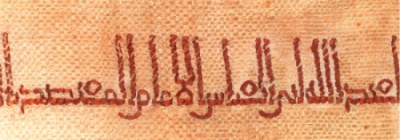
detail of inscription,
Tulunid period (868-905)
31,5 x 11cm, Inv.Nr. 1988.47
| ANNE WANNER'S Textiles in History / book reviews, articles |
| Marianne
Ellis Embroideries and samplers from Islamic Egypt published by Ashmolean Museum Oxford, 2001 text in English, 95 pages,
illustrated in colour |
| The embroideries illustrated in the book are from the Tulunid period (A.D. 868-905), Fatimid period (A.D. 969-1171), the Ayyubid period (A.D. 1172-1249) and the Mamluk Sultanate of Egypt and Syria, ending with the Ottoman conquest in 1517. |
|
| The majority date from the Mamluk period, during which embroidery was used to decorate a wide range of textiles. In the 1940s Professor Percy Newberry gave the Ashmolean Museum a collection of almost 2300 textiles, among them are more than a thousand Islamic fragments. When they came to the museum most of the fragments were stuck onto large portfolio sheets. Accompanying a few, in Professor Newberry's handwriting, were brief pencilled comments regarding the stitch, possible date or place of origin. They were part of a larger collection of embroideries that he and his wife had assembled, the majority of which are now in the Whitworth Art Gallery in Manchester. |
|
| In the 1940s Professor Percy Newberry gave the Ashmolean Museum a collection of almost 2300 textiles, among them are more than a thousand Islamic fragments. When they came to the museum most of the fragments were stuck onto large portfolio sheets. Accompanying a few, in Professor Newberry's handwriting, were brief pencilled comments regarding the stitch, possible date or place of origin. They were part of a larger collection of embroideries that he and his wife had assembled, the majority of which are now in the Whitworth Art Gallery in Manchester. |
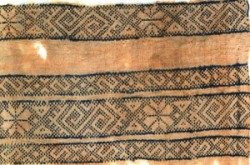 part of fragment, Mamluk period (1250-1517), linen embroidered with blue cotton, in pattern darning and running stitch, Inv.Nr. 1984.154 |
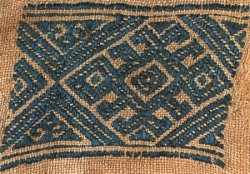 Sampler, Ayyubid period (1172-1249), linen, embroidered with blue silk, Inv.Nr. 1984.479 |
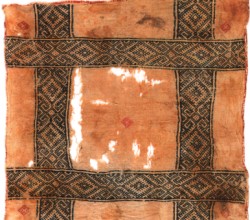 Square, Mamluk period (1250-1517), linen embroidered with blue and pink silk, Inv.Nr. 1984.173 |
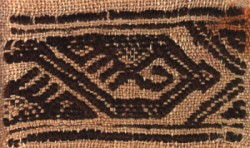 Sampler, Ayyubid period (1172-1249), linen, embroidered with brown silk, Inv.Nr. 1984.479 |
| Essie
Newberry also gave some items to the Embroiderers' Guild
to add to the portfolios loaned to members to study and
enjoy. She served on the Executive Committee of the Guild
for many years and her enthusiasm and love for the craft
were instrumental in the expansion of the organisation.
In their lifetimes the Newberrys encouraged others to
share their interest in historical embroideries and enjoy
their unique and wonderfol collection. Many of the embroideries are worked
in geometric patterns but there are also examples of
scrolling and arabesque desings, figurative motifs and
calligraphy. Beautiful writing is considered a major art
form in Islamic culture, and the collection includes an
embroidered tiraz band from Iraq or Iran with an
elegant flowing script worked in a variation of chain
stitch. |
| home content | Last revised June 24, 2001 | For further information contact Anne Wanner wanner@datacomm.ch |